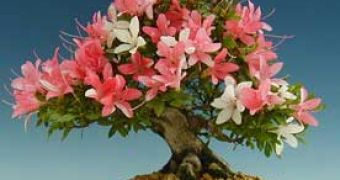Those Japanese can deliver you, like in a flowerpot, a 40 cm high oak tree, which may be older than you. Bonsai is the Japanese art of the miniature trees, but its roots are found in China, and the name bonsai comes from the Chinese "pun sai" (pun means "pot" and sai "tree"). This art originated during the 3rd century AD, when China was ruled by the Han dynasty. 900 years ago, this art was exported to Japan by traders and Buddhist monks. From Japan, it entered the western world.
At the beginning, trees and bushes were planted in flowerpots in order to be easily transported, as the leaves and bark of many had traditional curative use. Later, this was made for pleasure and further perfected. Bonsai art was reserved, until the 19th century, only to Japanese nobles and priests, who conferred it a sacred, philosophical and religious dimension.
At the origin, the bonsai trees were brought from the mountains. The seedling were collected following a ritual and they were planted in special greenhouses for acclimatization before being brought to the plain and planted in flowerpots. This type of bonsai is still more appreciated than that being 100 % the result of human work, but the activity is strictly restricted by law.
The most appreciated bonsai are those made with an azalea species (Rhododendron) (photo above), which in May can be completely covered by flowers. Grafting may permit the existence of varied colored flowers on the same bonsai.
Bonsai lovers or cultivators number reaches between 10 and 20 million in Japan alone.
A great variety of coniferous and deciduous trees like pine, yew, juniper, holly, beech, maple, but also fruit trees like plum and apple, Japanese varieties, can be grown as bonsai. Bonsai can be planted in flowerpots or flat stone slabs. Deciduous trees are preferred (except pine) because of the variety of offered colors along the seasons.
Man-grown dwarf trees are achieved by putting the seeds in very small pots. They germinate and are left in those pots until their numerous roots embrace all the soil, depleting it of minerals. The seedling is then transplanted into a little larger pot with a very small amount of soil. The action is repeated several times progressively to larger pots, till the final pot. The reason of moving the plant from one pot to another is to accommodate the plant to a low metabolism, which does not allow it a normal growth, so the plant remains dwarf.
The trunk and the branches barely grow as the root system is underdeveloped. But growing bonsai does not limit to dwarfing the trees: the trunk and the branches can be shaped, too.
They can be forced to grow in any direction, to spin, to fold in different plans; the tree can be turned spherical, ovoid, conic, pyramidal, and so on. Some branches are underdeveloped or removed, other can be cut in order to be replaced by others, regenerating from near-by. Bonsai can also be grafted.
Some tree species are very docile, like the conifers, while the dycotiledon trees are more rebel: a cut branch sprouts another. Sometimes, instead of cutting branches, cultivators slowly atrophy them. Bonsai art has reached such a level that experienced growers can obtain human faces, animals, diverse objects, and even animal or human caricatures from the trees.
It must be signaled that, if the bonsai trees are planted in normal conditions, they start growing normally. In Japan, most bonsai are left outside. They can have a sacred meaning, as the Shinto religion says gods live inside the trees.

 14 DAY TRIAL //
14 DAY TRIAL //